M2 Grows at Fastest Pace Since February
Even as the Fed talked about tightening monetary policy, the money supply grew at the fastest pace since last winter.
In the latest period, M2 increased by $263 billion. This is a major jump compared to the last two months and is the highest month-over-month growth since February. The same period in 2020 saw M2 only grow $62B.
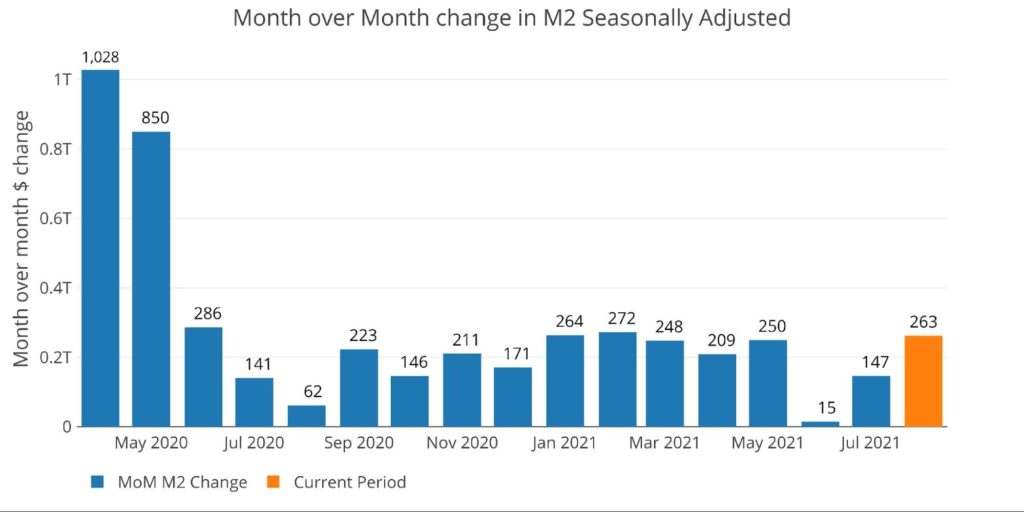
Figure: 1 MoM M2 Change
The table below shows the change in M2 over different period lengths. All numbers have been annualized for consistency. As can be seen, the growth in M2 is accelerating compared to the 6-month, 1-year, and 3-year average growth rates. A growth rate of 16.5% is extremely high, but it is only the most recent month and could be making up for the large dip seen in the previous 2 months. The 6-month growth rate is still well below the trend at 11.8%.

Figure: 2 M2 Growth Rates
M2 used to be published weekly, so the chart below shows the noisier weekly data that is not seasonally adjusted by the Fed (the chart and table above are seasonally adjusted).
The most recent week available ending Sept. 6 showed growth of $143B which is above the average since July 2020. After seeing big weekly drawdowns in the two prior monthly periods, the most recent period saw almost no declines in M2.
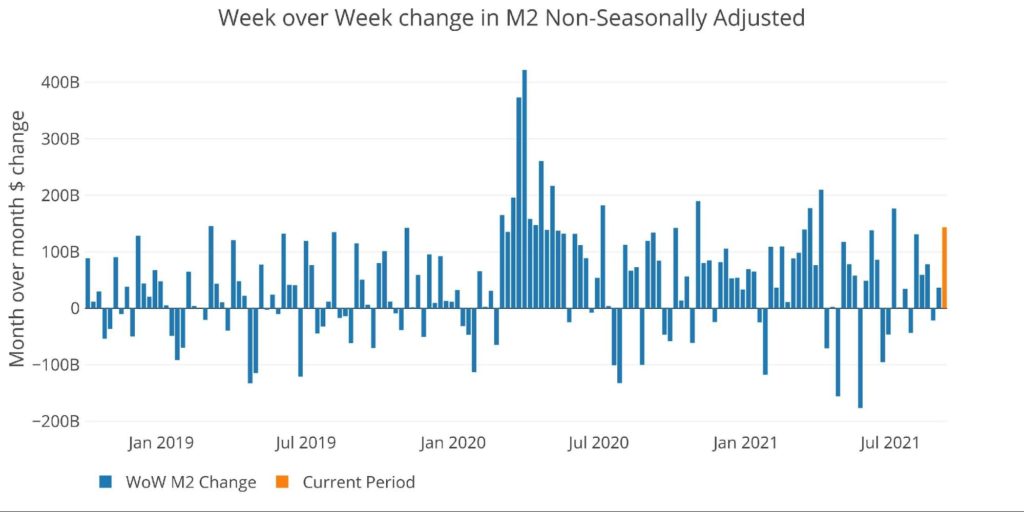
Figure: 3 WoW M2 Change
The “Wenzel” 13 Week Money Supply
The late Robert Wenzel of Economic Policy Journal used a modified calculation to track Money Supply. He used a trailing 13-week average growth rate annualized as defined in his book The Fed Flunks. He specifically used the weekly data that was not seasonally adjusted.
The objective of this analysis is to normalize the choppy data and get a better sense of the general Money Supply trend. In the table below, decelerating trends are in red and accelerating trends in green. The data shows that even with the large rebound seen in the recent period, Money Supply growth is still decelerating. While 7.7% growth is still high by historical standards, the economy has been used to growth rates as high as 17%.
The issue that the economy and stock market face (according to Wenzel) is that decelerating growth makes it harder for the economy to keep pushing forward and the stock market to continue driving higher.



The plot below helps show the seasonality of the Money Supply and compare the current year to previous years. The range of the y axis has been capped at 25% so that the massive spike in 2020 up to 60%+ does not skew the graph.
As shown, the trend has just moved past the annual summer dip that occurs every year except 2020. If the red bar starts to turn and begin moving upward it could help the stock market get out of the current sideways action. This will also drive inflation higher and potentially put a floor under gold and silver once traders realize the Fed is not going to fight inflation.
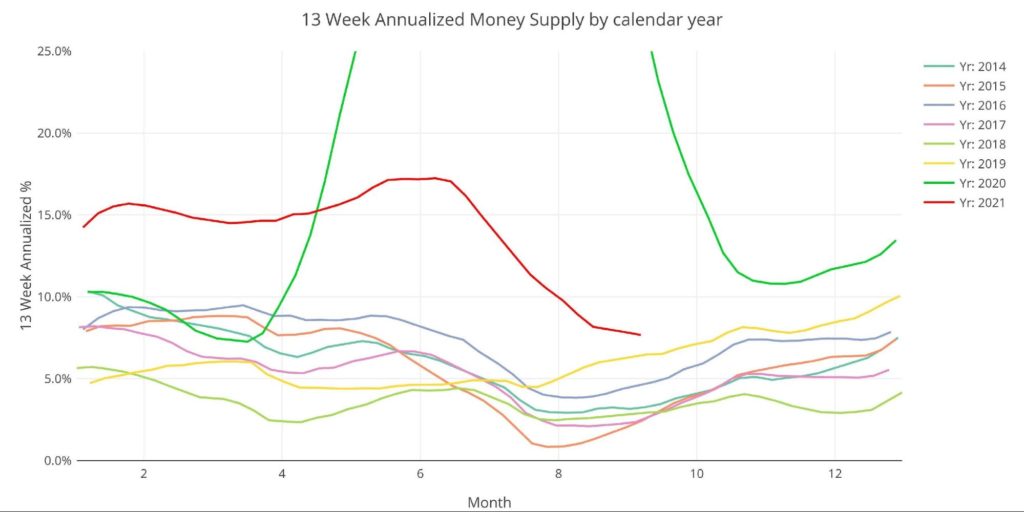
Figure: 7 Yearly 13 Week Overlay
Historical Perspective
The charts below are designed to put the current trends into a historical perspective. The orange bars represent annualized percentage change rather than the raw dollar amount. As can be seen, even the recent periods remain quite elevated compared to pre-Covid, driving total M2 through 20.8T in the most recent period.
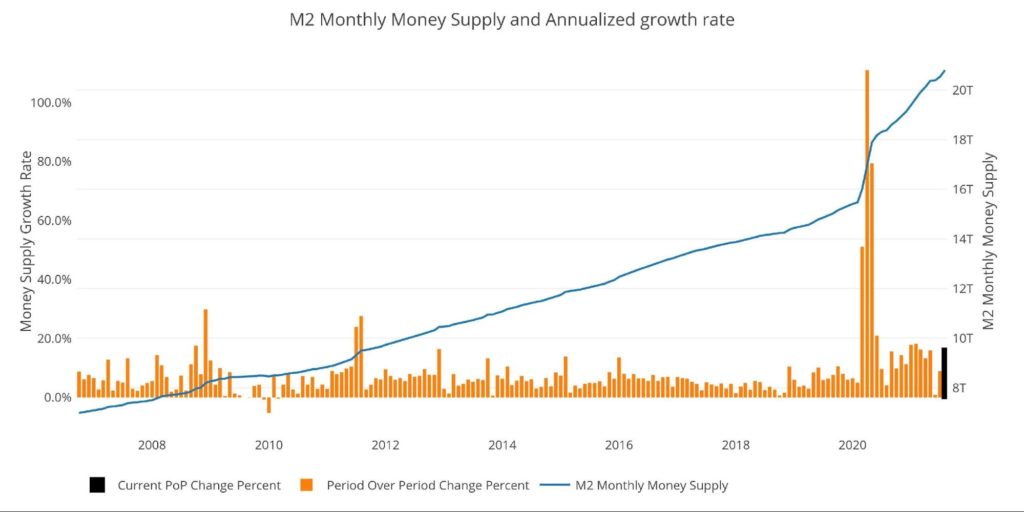
Figure: 8 M2 with Growth Rate
Taking a historical look at the 13-week annualized average also shows the unprecedented growth seen over the past 18 months. This chart overlays the log return of the S&P. Mr. Wenzel proposed that large drops in Money Supply could be a sign of stock market pullbacks.
His theory, derived from Murray Rothbard, states that when the market experiences a shrinking growth rate of Money Supply (or even negative) it can create liquidity issues in the stock market, leading to a sell-off. While not a perfect predictive tool, many of the dips in Money Supply precede market dips. Specifically the major dips in 2002 and 2008 from 10% down to 0%.
It could also be argued the pullback in 2018 could be due to an extended lead up of low Money Supply growth compared to previous years. More recently, the stock market has been moving sideways all summer as Money Supply growth has fallen rapidly compared to the prior year.
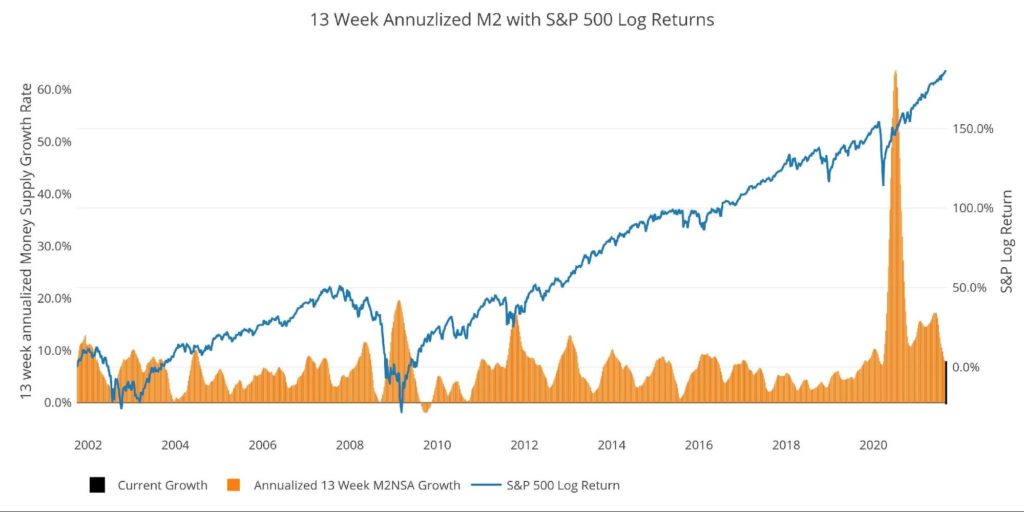
Figure: 9 13 Week M2 Annualized and S&P 500
Finally, it is important to consider the massive liquidity buildup in the system. The Fed offers Reverse Repurchase Agreements (reverse repos). Essentially this is a tool that allows financial institutions to swap cash for instruments on the Fed balance sheet.
Current Reverse Repo is hitting $1.36T dwarfing the old records of ~$500B in 2016-2017. This is up over $200B since last month alone. With this much liquidity in the system and Fed continuing to print, it’s hard to imagine it won’t continue driving the CPI higher.
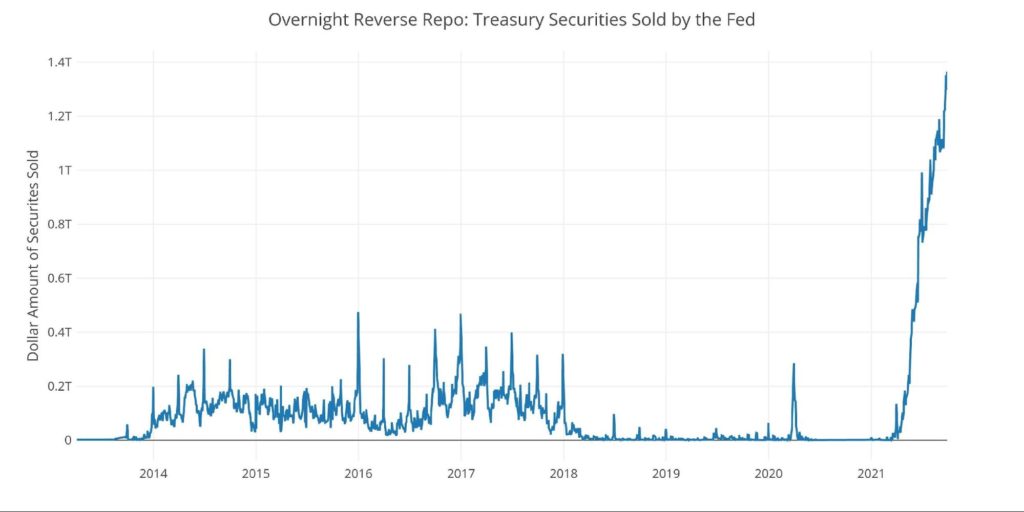
Figure: 10 Fed Reverse Repurchase Agreements
What it means for Gold and Silver
Inflation is an expansion of the Money Supply that generally leads to higher prices. Therefore, gold and silver can be used as protective assets to protect against dollar devaluation (higher prices). Money Supply has been growing at alarming rates for years now and has absolutely exploded over the last 2 years. It is hard to imagine this will not bleed into the CPI in the months and years ahead, even being designed to understate price increases (e.g. Owners’ equivalent rent).
If price increases prove to not be transitory as the Fed promises, gold and silver could be the biggest winners. With Money Supply growing like it has, “transitory” becomes very hard to believe.
Data Source: https://fred.stlouisfed.org/series/M2SL and also series WM2NS and RRPONTSYD. Historical data changes over time so numbers of future articles may not match exactly. M1 is not used because the calculation was recently changed and backdated to March 2020, distorting the graph.
Data Updated: Monthly on fourth Tuesday of the month on 3-week lag
Most recent data: Sep 06, 2021
Interactive charts and graphs can always be found on the Exploring Finance dashboard: https://exploringfinance.shinyapps.io/USDebt/





 The analysis below covers the Employment picture released on the first Friday of every month. While most of the attention goes to the headline number, it can be helpful to look at the details, revisions, and other reports to get a better gauge of what is really going on.
The analysis below covers the Employment picture released on the first Friday of every month. While most of the attention goes to the headline number, it can be helpful to look at the details, revisions, and other reports to get a better gauge of what is really going on. In February, the data showed that Yellen was making a big bet that long-term rates would not stay elevated for long. This was demonstrated by the volume of short-term debt issuance. The Treasury was willing to pay higher rates to keep the maturity of the debt shorter.
In February, the data showed that Yellen was making a big bet that long-term rates would not stay elevated for long. This was demonstrated by the volume of short-term debt issuance. The Treasury was willing to pay higher rates to keep the maturity of the debt shorter. Money Supply is a very important indicator. It helps show how tight or loose current monetary conditions are regardless of what the Fed is doing with interest rates. Even if the Fed is tight, if Money Supply is increasing, it has an inflationary effect.
Money Supply is a very important indicator. It helps show how tight or loose current monetary conditions are regardless of what the Fed is doing with interest rates. Even if the Fed is tight, if Money Supply is increasing, it has an inflationary effect. Please note: the CoTs report was published on 03/22/2024 for the period ending 03/19/2024. “Managed Money” and “Hedge Funds” are used interchangeably. The Commitment of Traders report is a weekly publication that shows the breakdown of ownership in the Futures market. For every contract, there is a long and a short, so the net positioning will always […]
Please note: the CoTs report was published on 03/22/2024 for the period ending 03/19/2024. “Managed Money” and “Hedge Funds” are used interchangeably. The Commitment of Traders report is a weekly publication that shows the breakdown of ownership in the Futures market. For every contract, there is a long and a short, so the net positioning will always […] The CME Comex is the Exchange where futures are traded for gold, silver, and other commodities. The CME also allows futures buyers to turn their contracts into physical metal through delivery. You can find more details on the CME here (e.g., vault types, major/minor months, delivery explanation, historical data, etc.).
The CME Comex is the Exchange where futures are traded for gold, silver, and other commodities. The CME also allows futures buyers to turn their contracts into physical metal through delivery. You can find more details on the CME here (e.g., vault types, major/minor months, delivery explanation, historical data, etc.).